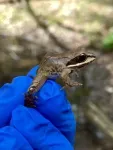(Press-News.org) The world’s amphibians are in trouble. Because of their sensitivity to climate change, habitat loss, and pollution, they may be the canary in the coalmine for the nascent anthropogenic mass extinction. Approximately 200 amphibian species have become extinct since the 1970s, and the International Union for the Conservation of Nature estimates that 34% of the 7,296 known remaining species are likewise at risk.
Another reason why amphibians are vulnerable is their susceptibility to disease. An emerging, potentially deadly disease of frogs and salamanders is ranavirus, a genus of at least seven species within the family Iridoviridae. Ranavirus can rapidly jump from host to host among fish, amphibians, and reptiles: a flexibility that can have catastrophic consequences, if new host species haven’t yet evolved any immunity.
But as a new study in Frontiers in Amphibian and Reptile Science has now shown, amphibians aren’t entirely defenseless against ranavirus.
“Here we show that in response to ranavirus, wood frog tadpoles change their growth, development, and resource allocation. This may help tadpoles tolerate the energetic demands of infection or escape risky environments to avoid infection entirely,” said Logan Billet, a PhD student at Yale University and the study’s first author.
Ranavirus has been implicated in 40 to 60% of amphibian die-offs in the US. Infected larvae stop feeding and become lethargic, while swimming abnormally and bleeding internally. An outbreak often leads to the death of all larvae in a pond, and there is evidence that outbreaks are becoming more frequent due to climate change.
Small frog in a big pond
Between 2021 and 2023, the authors studied the growth and development of the wood frog Rana sylvatica in a forest in Connecticut. Wood frogs are so-called ‘explosive’ breeders in ponds formed from snowmelt. They compared three pond types: 35 which remained free from ranavirus over an entire season; seven which contained some infected tadpoles but saw little or no mortality; and five with an outbreak that killed off the entire cohort.
From mid-April to mid-July, the researchers regularly visited ponds to estimate the number of live and dead individuals. They collected up to 20 tadpoles from each and humanely euthanized them. In the laboratory, they determined the presence or absence of ranavirus in the liver of 1,583 of these with quantitative real-time PCR. They also measured the total length of 4,299 tadpoles and determined their developmental stage – the so-called Gosner stage, which ranges from zero for embryos to 42 for tadpoles on the brink of metamorphosis.
Because of the life-history plasticity common to many amphibians, growth and development can vary independently: for example, tadpoles may grow slowly and thus be smaller than average, yet relatively large for their Gosner stage due to lagging development.
The results showed that tadpoles in ‘die-off’ ponds at first grew significantly faster, which led to a larger body size over the first month of life. Tadpoles also matured faster in die-off ponds, being on average 0.38 stages ahead in their development. But once mass mortality started, the rate of growth and development in these pools crashed, so that they were overtaken in body size and stage by those in uninfected or uninfected ponds, and ended up small for their stage at their death from the disease.
Similarly, in infected ponds that ultimately saw no die-off, tadpoles grew significantly faster and developed precociously over the first month of life, so that they were larger in body size as well as on average 1.7 Gosner stages ahead of tadpoles in uninfected ponds.
Being frogmarched throughout development
The authors conclude that tadpoles respond to the presence of ranavirus by speeding up their growth rate and progressing through successive developmental stages faster early in life.
“Accelerating growth and resource allocation early on may allow tadpoles to improve their physical condition, and thus the strength of their immunity, in anticipation of infection. They might also metamorphose and move onto land earlier, potentially reducing their exposure to ranavirus,” said senior author Dr David Skelly, a professor at the Peabody Museum and Billet’s doctoral supervisor.
“These responses are likely to give tadpoles a survival advantage. We hypothesize they are the reason why mortality wasn’t always 100%, but only partial in some outbreaks in our study.”
“What we don’t yet know is how tadpoles detect ranavirus in their environment, for example through chemical or visual cues, and how effective these responses improve survival or tolerance of infection. Controlled experiments will be important to address these questions,” said Billet.
END
Tadpoles try to flee dangerous virus in their pond by growing much faster than normal
Larvae of wood frogs respond to presence of deadly ranavirus by growing and maturing precociously
2025-03-26
ELSE PRESS RELEASES FROM THIS DATE:
Build it and they shall come
2025-03-26
Designing walkable neighborhoods has gained attention as a method to increase physical activity among urban populations. Moreover, highly walkable areas stimulate increased neighborhood retail sales, higher property values, and greater urban sustainability. However, only limited methods are available for improving walkability in the urban centers of highly motorized suburban cities. In the urban areas of suburban cities, increasing land-use diversity by opening a multifunctional facility is considered one of the most effective strategies for an architecture-scale intervention.
Dr. Haruka Kato, ...
How elephants plan their journeys: New study reveals energy-saving strategies
2025-03-26
UNDER EMBARGO UNTIL 05:01 GMT / 01:01 ET WEDNESDAY 26 MARCH 2025
How elephants plan their journeys: New study reveals energy-saving strategies
A new study has revealed that African Elephants have an extraordinary ability to meet their colossal food requirements as efficiently as possible. Data from over 150 elephants demonstrated that these giants plan their journeys based on energy costs and resource availability. The findings – published today (26 March) in the Journal of Animal Ecology– could provide crucial information to help protect these iconic animals and their habitats.
Being an elephant is no easy task. As massive herbivores weighing several ...
New study challenges the ‘monogamy-superiority myth’, as non-monogamous people report just as happy relationships and sex lives
2025-03-26
Monogamous and non-monogamous individuals report similar levels of satisfaction in both their relationships and sex lives, according to a comprehensive new meta-analysis.
Published today in The Journal of Sex Research, the peer-reviewed study debunks the prevailing belief that monogamous relationships – defined as exclusive romantic and sexual commitment to one partner – are inherently superior in fostering fulfilling relationships compared to alternative structures.
While monogamy has been the predominant type of relationship in much of recent Western history, many individuals choose alternative structures. Non-monogamy includes various ...
Government of Guyana, Mount Sinai Health System and Hess Corporation announce five-year extension of national healthcare initiative.
2025-03-26
His Excellency Dr. Irfaan Ali, President of the Co-operative Republic of Guyana, today announced a five-year extension of the national healthcare initiative to transform Guyana’s public health system with world-class healthcare services accessible to every Guyanese citizen. This next phase of the initiative, launched in 2022 by the Government of Guyana in collaboration with the Mount Sinai Health System and Hess Corporation, will include establishment of a national cancer center, continued modernization of national health facilities including Georgetown Public Hospital Corporation, and the implementation of one ...
Preclinical study: after heart attack, a boost in anti-inflammatory cells promoted healing
2025-03-26
A scientific technique that rapidly increases the body’s production of anti-inflammatory cells promoted healing from heart attacks in mice, according to a new study by investigators from the Smidt Heart Institute at Cedars-Sinai. Once adapted to treat humans, the technique could potentially be used to repair heart muscle damage after a heart attack and be applied to a variety of inflammatory disorders.
The investigators’ findings were published in the peer-reviewed Journal of Clinical Investigation.
Heart attacks occur when the heart muscle is damaged by reduced blood flow from one or more arteries. They strike more than ...
Glucose revealed as a master regulator of tissue regeneration in Stanford Medicine study
2025-03-26
The sugar glucose, which is the main source of energy in almost every living cell, has been revealed in a Stanford Medicine study to also be a master regulator of tissue differentiation — the process by which stem cells give rise to specialized cells that make up all the body’s tissues.
It does so not by being catabolized, or broken down, to release the energy sequestered in its chemical bonds, but instead by binding in its intact form to proteins that control which genes in the genome are made into proteins and when.
The discovery of glucose’s undercover double life was so surprising the researchers ...
Open-label placebo appears to reduce premenstrual symptoms, study suggests
2025-03-25
Women affected by premenstrual syndrome (PMS) appear to experience less intense and debilitating symptoms after taking placebo pills even when told they do not contain any active medication, suggests a study published in the open-access journal BMJ Evidence-Based Medicine.
PMS can result in significant distress for women of reproductive age and cause psychological symptoms such as irritability, depressed mood, and mood swings as well as physical symptoms including breast tenderness, bloating, and joint pain.
Women ...
New mums advised to do two hours of moderate to vigorous exercise a week
2025-03-25
New mums should be strongly encouraged to begin clocking up at least two hours of moderate to vigorous intensity physical activity such as brisk walking and muscle strengthening exercises each week in the first three months after birth, when physically able, to improve health and well-being, say experts in a new guideline published by the British Journal of Sports Medicine.
They also strongly recommend daily pelvic floor muscle training to reduce the risk of urinary incontinence, and taking steps to improve sleep ...
Milk as Medicine: New Study Shows Breast Milk Transforms Challenges into Triumphs
2025-03-25
OKLAHOMA CITY – In 2010, University of Oklahoma researcher David Fields, Ph.D., was pouring over research data when he discovered something he thought was odd: His data showed that at 6 months of age, formula-fed babies born of mothers who were categorized as medically obese weighed about 5% units less fat than breastfed babies in the same dataset. That discovery struck him as unusual and led him on a research journey to better understand breast milk. Now, he’s studying the connections between maternal gestational diabetes, breastfeeding and infant health.
Fields is part of the research team behind a recent study ...
CU Cancer Center researchers identify the ‘switch’ that allows intestinal cells to regenerate after injury
2025-03-25
Researchers from the University of Colorado Cancer Center have solved a cellular mystery that may lead to better therapies for colorectal and other types of cancer.
Peter Dempsey, PhD, professor of pediatrics–developmental biology in the CU School of Medicine, and Justin Brumbaugh, PhD, assistant professor of molecular, cellular, and developmental biology at CU Boulder, recently published a paper in the journal Nature Cell Biology showing the importance of the H3K36 methylation process in regulating plasticity and regeneration in intestinal cells.
“The intestine has an ...
LAST 30 PRESS RELEASES:
Sport in middle childhood can breed respect for authority in adolescence
From novel therapies to first-in-human trials, City of Hope advances blood cancer care at the American Society of Hematology (ASH) annual conference
Research aims to strengthen the security of in-person voting machines
New study exposes hidden Alzheimer’s 'hot spots' in rural Maryland and what they reveal about America’s growing healthcare divide
ASH 2025: Study connects Agent Orange exposure to earlier and more severe cases of myelodysplastic syndrome
ASH 2025: New data highlights promise of pivekimab sunirine in two aggressive blood cancers
IADR elects George Belibasakis as vice-president
Expanding the search for quantum-ready 2D materials
White paper on leadership opportunities for AI to increase employee value released by University of Phoenix College of Doctoral Studies
ASH 2025: New combination approach aims to make CAR T more durable in lymphoma
‘Ready-made’ T-cell gene therapy tackles ‘incurable’ T-cell leukemia
How brain activity changes throughout the day
Australian scientists reveal new genetic risk for severe macular degeneration
GLP-1 receptor agonists likely have little or no effect on obesity-related cancer risk
Precision immunotherapy to improve sepsis outcomes
Insilico Medicine unveils winter edition of Pharma.AI, accelerating the path to pharmaceutical superintelligence
Study finds most people trust doctors more than AI but see its potential for cancer diagnosis
School reopening during COVID-19 pandemic associated with improvement in children’s mental health
Research alert: Old molecules show promise for fighting resistant strains of COVID-19 virus
Journal of Nuclear Medicine Technology supplement highlights advances in theranostics and opportunities for growth
New paper rocks earthquake science with a clever computational trick
ASH 2025: Milder chemo works for rare, aggressive lymphoma
Olfaction written in bones: New insights into the evolution of the sense of smell in mammals
Engineering simulations rewrite the timeline of the evolution of hearing in mammals
New research links health impacts related to 'forever chemicals' to billions in economic losses
Unified EEG imaging improves mapping for epilepsy surgery
$80 million in donations propels UCI MIND toward world-class center focused on dementia
Illinois research uncovers harvest and nutrient strategies to boost bioenergy profits
How did Bronze Age plague spread? A sheep might solve the mystery
Mental health professionals urged to do their own evaluations of AI-based tools
[Press-News.org] Tadpoles try to flee dangerous virus in their pond by growing much faster than normalLarvae of wood frogs respond to presence of deadly ranavirus by growing and maturing precociously





